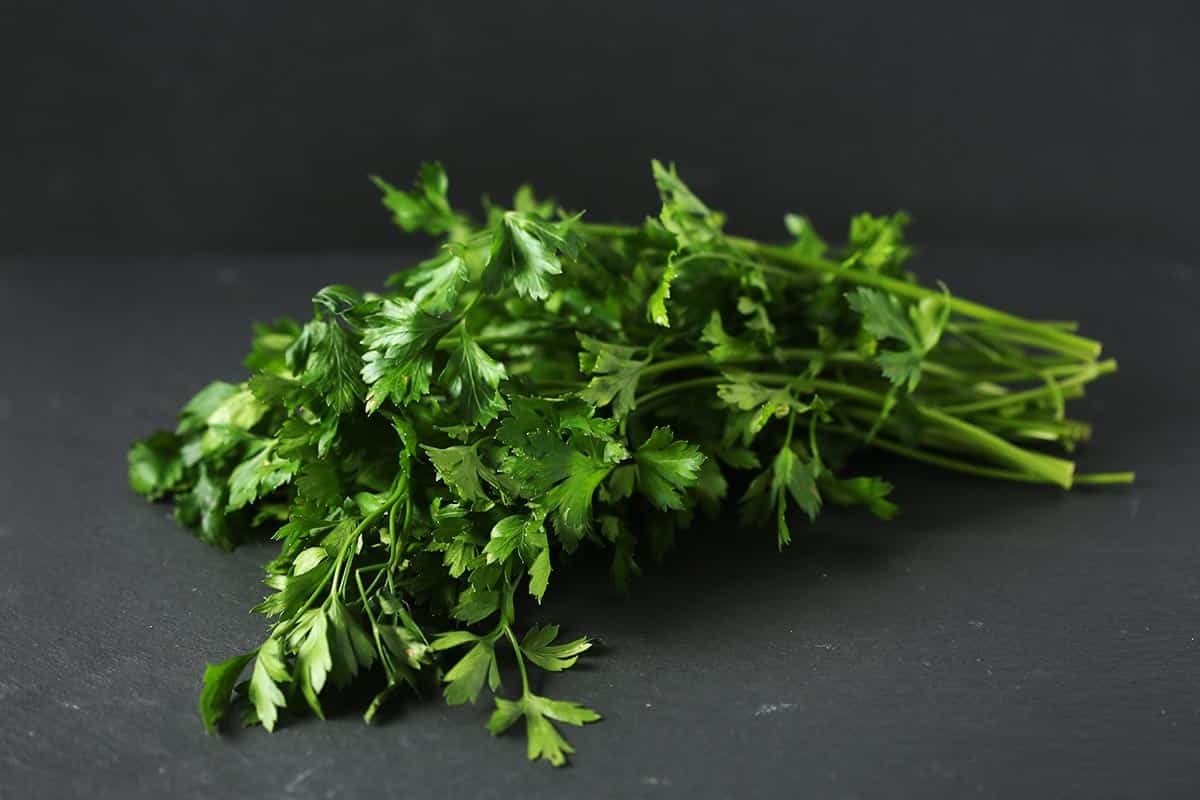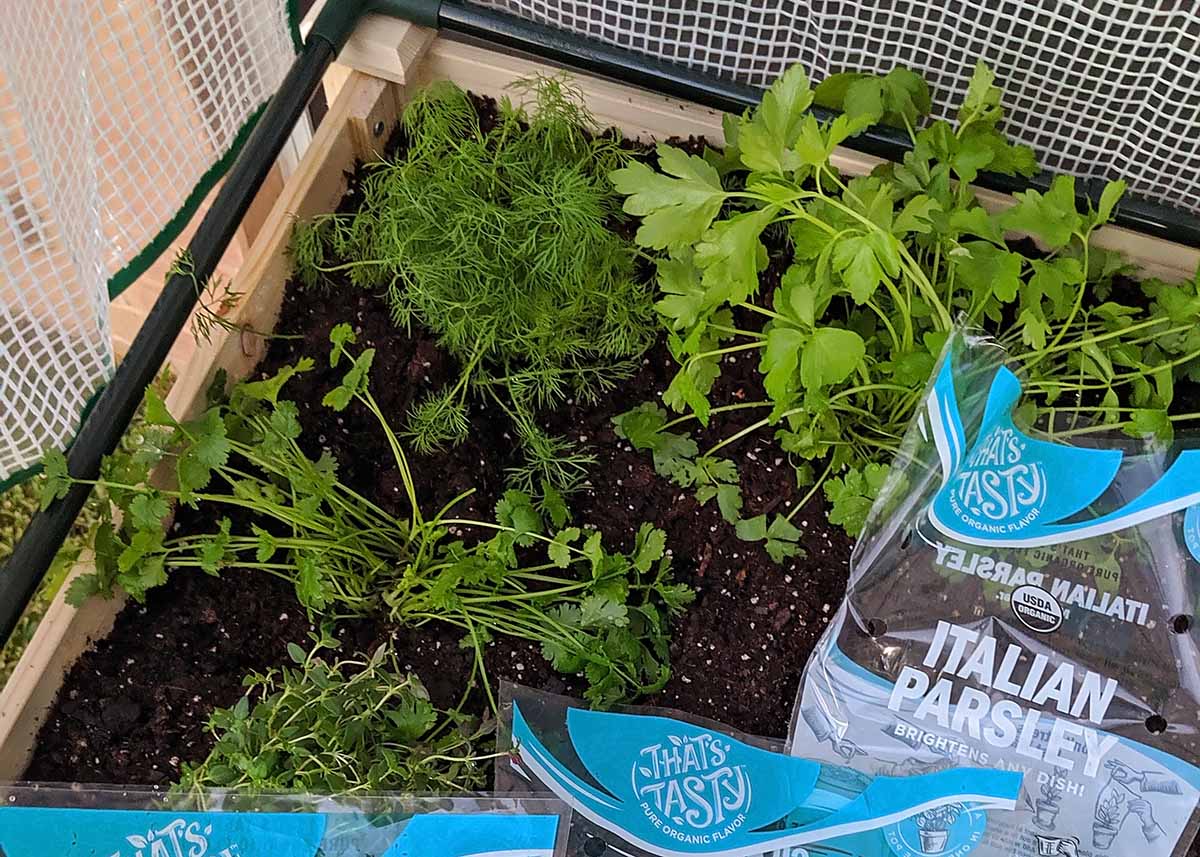You might be wondering, “What does parsley taste like?” In this article, we’ll discuss that and more. Read on and learn all things about this herb.
Parsley is most commonly utilized as a garnish. As some people tend to treat garnishes merely as decorations, they move them to the side and do not eat them. For this reason, many people might have already seen parsley but have not tasted it.

Parsley’s scientific name is Petroselinum crispum. It is an herb that belongs to the Apiaceae or Umbelliferae family. This family of herbs is known for its aromatic flowers. It is the same family to which carrots, coriander, chervil, cumin, dill, and fennel belong.
Parsley is native to the Mediterranean. It was used as a medicine for various illnesses in the early times. Yet, its uses as a flavoring and a garnish were not common back then.
Parsley is available in both fresh and dried forms. You can easily grow them at home or find them in local grocery stores.
Parsley is a kitchen staple because it is a versatile herb. There are many uses for it, including the following.
The most common use of parsley is as a garnish. This green herb elevates the look of dishes and makes a nice decoration.
You can sprinkle in chopped parsley on just about anything. These include rice, soup, meat, and vegetable dishes.
Whole leaves with a bit of the stem can also be used as a garnish if preferred.
Note that even when placed there as decoration, garnishes are supposed to be edible. As a rule, anything served on your plate can be eaten. So, go ahead, eat that parsley!
Parsley is also prized for its delicate flavor, which we’ll discuss more in a bit. That said, it can be added to dishes if you want a burst of flavor. You can make parsley butter, add them to eggs, or include them in salads. You can also use them to make pesto.
Note that you should add fresh parsley at the end of the cooking process. If you are after its flavor, you will be disappointed to know that it quickly dissipates when cooked.
Parsley is also a component of the famous herb blend “fines herbes”. This herb mix translates to “fine herbs” and is widely used in French cuisine.
Fine herbs combine parsley, tarragon, chives, and chervil. It is used as a flavoring for dishes. Yet, like parsley, the other herbs in this mix also lose flavor when heated. That said, fines herbes blend is typically added to cooked dishes after the cooking process or at the very end.
Bouquet garni means “garnished bouquet” in English. It is usually a combination of parsley, bay leaves, and thyme. When fresh herbs are used, they are typically bundled with cooking twine. On the other hand, dried herbs are usually wrapped in cheesecloth and secured with twine. The bundling and wrapping make it easy for the herbs to be removed at any point while cooking.
Parsley is the base of the sauce chimichurri. To make it, you’ll need to chop parsley, garlic, and oregano finely. Then, stir in red wine vinegar and olive oil. Finally, add salt and red pepper flakes.
Chimichurri is often served as a condiment to steak. But it can also be used as a dip and a salad dressing. Drizzle this vibrant green sauce into toast, eggs, and pizza.

Here are 4 of the most common types of parsley.
This type of parsley has a delicate flavor. Because of this, it is the most common type of parsley used in uncooked applications, such as a garnish.
Its curly, ruffled leaves are more aesthetically pleasing than other parsley leaves. Not to mention, its bright green leaves also add a pop of color to otherwise bland-looking dishes.
Curly parsley can also be added to salads where the other ingredients taste subtle. This way, its flavor will not be overpowered.
Italian parsley, or flat-leaf parsley, has a stronger flavor than curly-leafed ones. For this reason, this is the go-to parsley when used for cooking. They hold better to heat. Yet, if you want to maximize their flavor, you should still add them toward the end of the cooking process.
Italian parsley is most commonly used in meat dishes and for making chimichurri.
This type is native to Japan and China and is characterized by its bitter taste. Its flavor is often compared to celery. That said, they make good additions to soup and egg dishes. When it comes to appearance, the Japanese parsley’s pointy leaves grow in sets of three. This makes it easy to identify them among other parsley types.
If you look at just the leaves, you might mistake this type for Italian parsley. However, looking at the roots, you’ll see that the Hamburg parsley grows a tuber. This is why it is also called parsley root or root parsley.
This tuber looks a lot like carrots; the only difference is that they are white. Root parsley is often cooked and added to salads.
So, what does parsley taste like? Well, this leafy green herb has a subtle flavor. Parsley has a fresh vegetal taste with a bitter note. You’ll also get hints of a peppery taste when eating this herb.
The taste of parsley is rather delicate when compared to other herbs. Yet, among the 4 types of parsley, the most flavorful is the flat-leaf parsley. It has a more robust flavor than other kinds.
That said, it is the top choice for cooked dishes.
The leaves of parsley and celery look the same. Some people even mistake one for the other, and that is unsurprising. That said, you might ask: “Does parsley taste like celery?”
The answer is not exactly. They both taste herby, but celery has a distinct taste similar to anise and licorice. Parsley does not have this flavor note.
Flat-leaf parsley and cilantro might look the same at first glance, but they do not taste similar.
First, parsley has a mild flavor, while cilantro has a strong taste. Second, cilantro has a note of citrus, while parsley does not.
Aside from the taste, there are 2 more ways to tell parsley and cilantro apart.
First, you can differentiate them by smelling them. Parsley has a mild and herby smell, while cilantro has a strong aroma. The latter also has a distinct citrus smell.
Second, you can also tell them apart by closely inspecting the leaves. At first glance, these leaves look the same. When you take a closer look, though, you’ll notice that their leaves have a subtle difference.
Parsley has elongated, pointy leaves. On the other hand, cilantro has more rounded leaves.
You should not use parsley and cilantro interchangeably, as they have different flavors. So, directly substituting one for the other will affect the taste of your dish.
You should add a little lemon juice when using parsley instead of cilantro. This will compensate for the missing citrus note.
With parsley, you can make pesto sauce. Parsley is also the main ingredient in chimichurri sauce. This sauce can be eaten with meatballs, grilled meat, and fish.
Add them to stuffed peppers, sandwiches, burgers, and quiche. They also make great additions to dips and salad dressings.
Vegetable salads, garlic bread, and baked pasta also taste better with parsley. Some popular savory dishes that include parsley are Chicken Picatta, tabbouleh, and gremolata.
Cilantro’s citrusy flavor pairs well with lots of dishes. For starters, you can use cilantro for tacos, corn chowder, and pasta salads.
It is a common ingredient in Bahn Mi, Pad Thai, and Goulash recipes. Cilantro is also popular in shrimp and grits, rice, and chicken dishes.

The parsley’s mild and delicate taste pairs well with many other foods. Some of the flavors that go well with it are:
Parsley is a good source of Vitamins A and K.
It also contains calcium, phosphorus, folate, and potassium. Parsley also boasts iron and magnesium. That said, adding parsley to your recipes can make them more nutritious.
Yes. Parsley is rich in Vitamin A, which promotes better eye health. On top of that, it has a significant amount of Vitamin K. This is essential for stronger bones.
The greatest indicator of freshness in parsley is its color. If it loses its vibrant green color, it has begun to spoil.
Many people think that parsley does not have a flavor of its own. This is not true, though. Aside from adding color to dishes, its subtle flavor can elevate any dish you add it to. It has a peppery and herbal flavor with a bit of bitterness.
You should remember that this mild flavor quickly gets lost upon cooking. That said, fresh parsley should never be added to dishes early in the cooking process. The opposite is true, though, for dried parsley.
You should add dried parsley immediately as it needs time to release its flavor. Nevertheless, parsley, in both forms, is versatile. It can pair well with other flavors.





